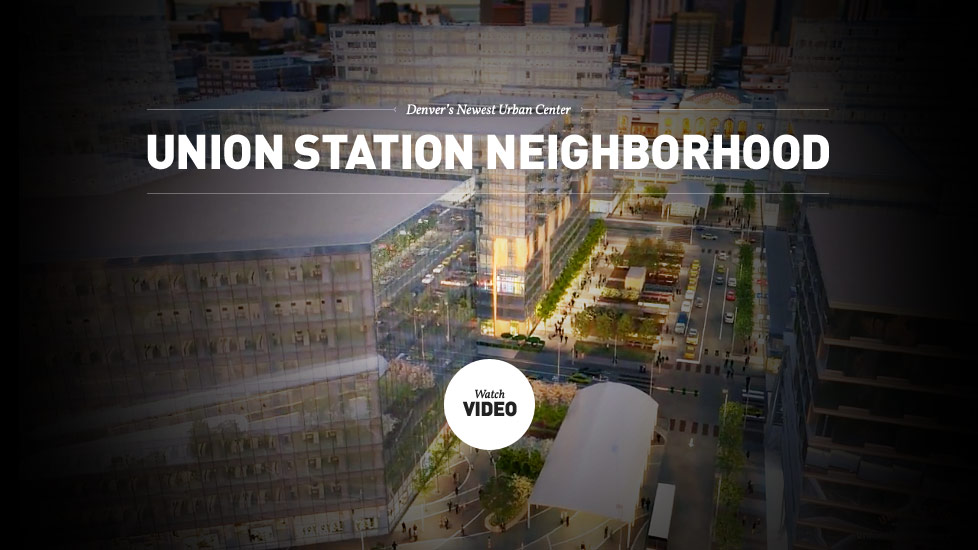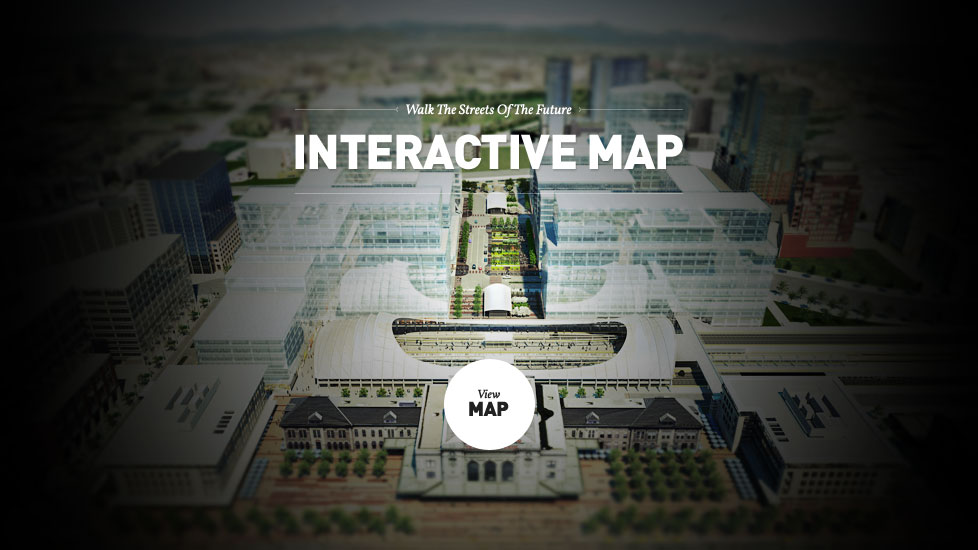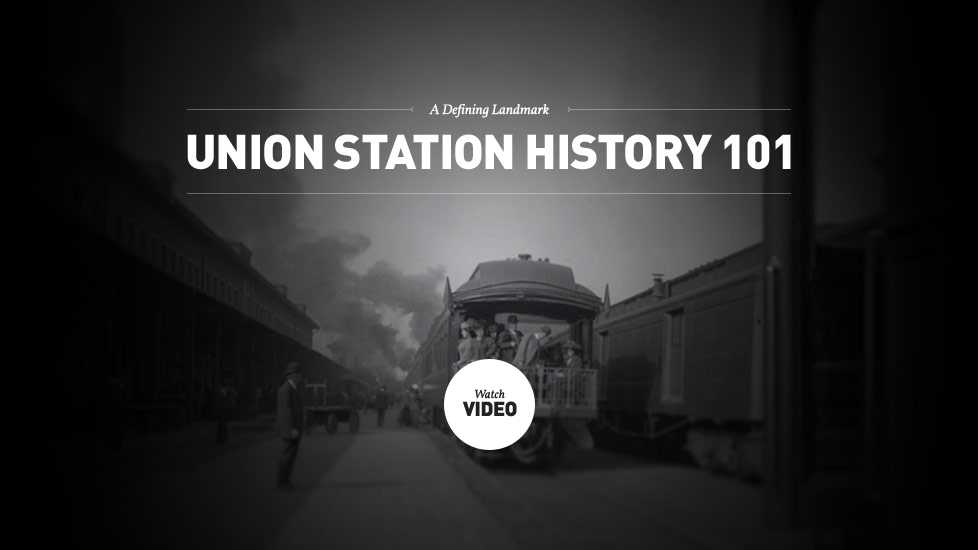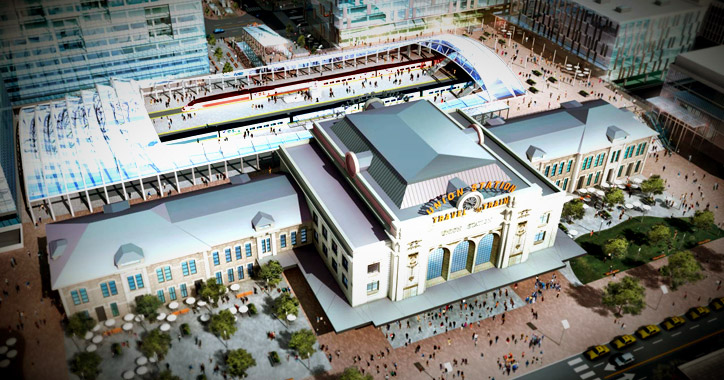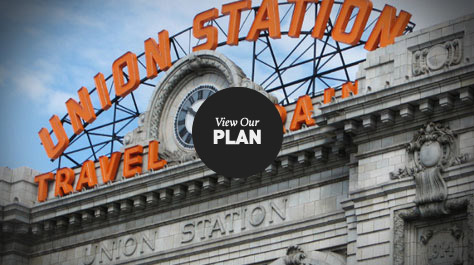Come Check Out... The Neighborhood, An Urban Renaissance
The space between the buildings and platforms will serve as both a destination and a gateway, a place to sit still and a place of constant movement. Contemporary installations, murals and water features will pepper the sidewalks. Cafes will fill the air with the smell of signature dishes. Lawns and courtyards will make the perfect venue for outdoor concerts, festivals, holiday parades, fireworks displays and family picnics. In contrast to the retail stores sprinkled throughout the neighborhood, we’ve also allotted space alongside the historic station for a seasonal market where farmers, artists and craftsmen can sell their fresh produce and art. This new neighborhood will welcome tourists, recharge commuters and give Denver locals a place to shop, dine, explore, play and relax, right in their own backyard—or just a short commute away.
Public Spaces
Historic Train Room
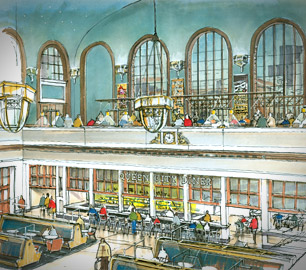
The heart and soul of the Union Station neighborhood redevelopment plan is the historic Union Station building. It will serve as the main waiting space for passengers and will house baggage claim, rental car kiosks, information, stores, cafes and an entry to the marketplace. This will be a vibrant place, bustling with travelers and locals alike. It will be a place that belongs to our community, celebrates our history, and serves as the gateway to and from downtown Denver.
Market
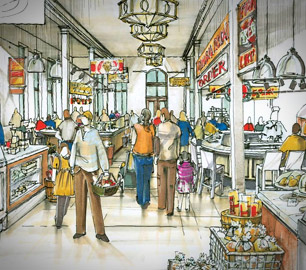
The historic station market will give local vendors the chance to operate retail kiosks at the main transportation hub. Drawing visitors and locals alike, the market will offer a wide variety of produce, pastries and handmade items to take home or to enjoy on the commute.
North Plaza
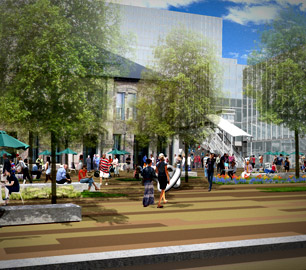
A bisque of trees. A granite seat wall. Cafes spilling out into the plaza. Commuters passing through to grab their train. Husbands dropping off wives as they catch their train to the airport. The North Plaza, fronted by the IMA Financial Center and the historic Union Station, is the quiet public space so missing in LoDo. A shaded, quiet place to meet friends, grab a cup of coffee and a bite to eat before heading back out to meet the city head on.
South Plaza
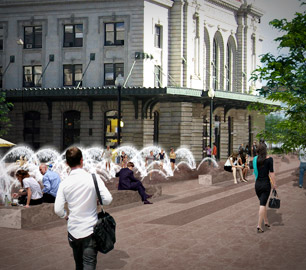
Designed to be the hub of pedestrian activity at Union Station, the South Plaza is designed around a fountain spreading over almost a quarter of an acre. The fountain itself can be turned off in order to convert the space to a farmer’s market, a concert venue, a dance hall, and other uses not yet imagined. The space is both gateway and destination, play area and meeting area.
Train Shed
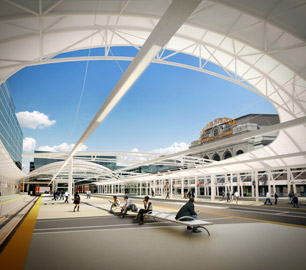
Out what used to be the back door of Union Station will be the architectural statement of the entire project. The train shed, home to railways to Denver International Airport, Boulder and Westminster, has been designed to honor the historic station and its iconic “Travel by Train” neon sign. Every technical element, from the tracks to the powerlines, has been designed to engage the eye and to make life more convenient for the passenger.
Wewatta Plaza
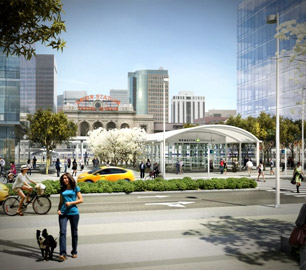
A new place where none existed before, Wewatta Plaza is the northern entrance into the Train Hall. One of three entry points into the underground bus barn, the plaza is also the axis point of the new neighborhood, where the neighborhood completes its transition from historic character of LoDo to the modern nature of the Union Station neighborhood.
17th Street Vertical Gardens
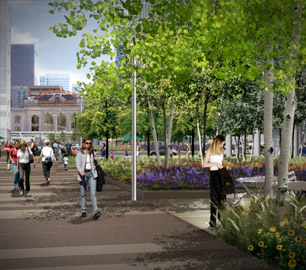
A series of gardens running parallel to 17th Street and connecting the north bound trains to the south bound trains, the 17th Street Vertical Gardens are the spine of the neighborhood. Each garden measures about 40 by 20 feet and features a different Colorado ecosystem, from turf to fountains to the glass skylights of the bus barn below, the gardens provide for shade and cool at the heart of the neighborhood. And the promenade along 17th Street will become the central gathering point in all of downtown.
Light Rail Station
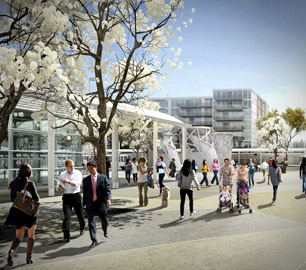
The venting tubes from the underground bus station provide the design challenge that make the Light Rail station as important and iconic as any other part of the new Union Station. Connected to the bus barn below, the 16th Street Mall, the 17th Street Gardens, and, of course, all of south Denver via light rail, the Light Rail Station will be the primary point of entry to downtown for more than half of downtown Denver’s employees.
Bus Barn
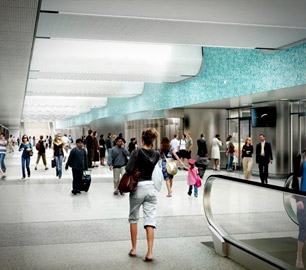
Buried but not forgotten, the bus barn is the single most expensive component of the entire station development. Inspired by the most modern airport terminals, the pedestrian corridor connects the two train stations together and provides a waiting terminal for the regional buses. Bathed in natural light from skylights above and finished in terrazzo tile, the bus barn is more airport terminal than bus station.
Green Initiatives
By integrating sustainable design, construction and operation we’re not only setting a new standard in sustainable urban redevelopment, we’re extending the relevance and significance of historic Union Station for decades to come. Here are some of the major steps we’re taking.
Promote Transportation Alternatives
We’re supporting and encouraging alternative transportation with features like bicycle lanes, a bike center, easy pedestrian access and quick transitions to buses, light rail and Amtrak.
Advance Sustainable
Urban Design
We aim to create vibrant, inspiring and sustainable places where people can play, work, live and travel.
Incorporate Green
Standards
We are integrating sustainable building techniques and green development goals throughout the historic renovation.
Minimize
Waste
We are working to minimize our footprint through best design, construction and operational practices and recycling onsite waste as much as possible.
Reduce
Energy Cost
We’ll improve energy efficiency and use renewable energy sources wherever possible to reduce reliance on fossil fuels.
Be Climate
Wise
We’ll reduce or eliminate greenhouse gas emissions during development.
Clear
the Air
We’re promoting excellent indoor and outdoor air quality throughout all of the development area.
Conserve
Water
We’re monitoring our consumption in all aspects of development, working in partnership with the Water Department.
Use Stormwater as
a Resource
We’re utilizing innovative on-site storm water management techniques to reduce flood risk and improve water quality and site aesthetics.
Engage Visitors
& Residents
We’ll use on-site public education materials to engage metro area residents in sustainable practices, principles and transit benefits.
Evolve
We’ll adapt to new best practices as they change with improvements in technology and design standards.
Historic Station Reuse
What makes the Union Station redevelopment so unique is its near extinct combination of form and function. In recent decades, cities across the country have watched as their beloved train stations were demolished and replaced—sometimes with more efficient, less aesthetic replacements, like New York City’s Pennsylvania Station, and sometimes with vacant lots, like Chicago’s Central Station. Some stations survived—like Tulsa’s Union Depot—but these architectural landmarks don’t see trains anymore.
That’s why the transformation taking place between Wynkoop and Riverfront Park is so magical. The Union Station Neighborhood Co. and its partners—governed by Denver’s landmark preservation committee—are evolving a historical icon from the bustling hub it once was into a progressive solution to a complex transportation challenge. All this, packaged within a contemporary and unparalleled urban transformation. Nowhere else in the country can boast this same feat.
The owner of the historic Union Station, RTD, has begun an RFP process to select a developer of the historic station. The Union Station Neighborhood Company, believing that the historic station is the key component to the company’s entire plan for the neighborhood is pursuing selection.
